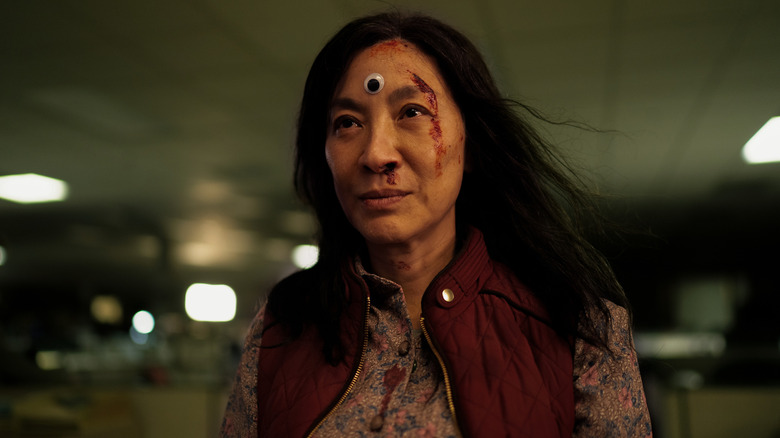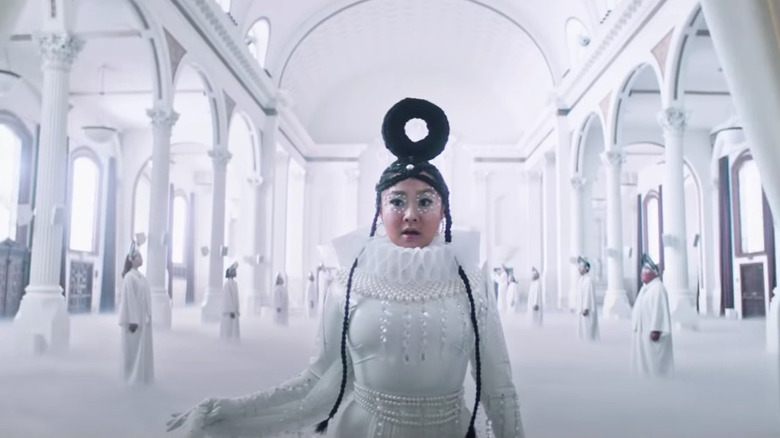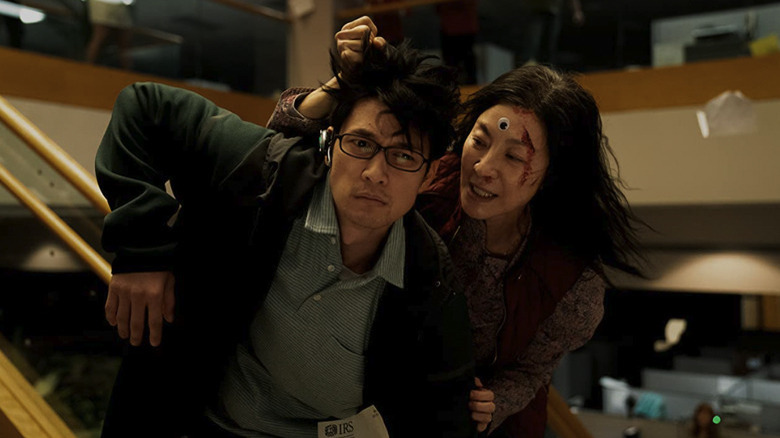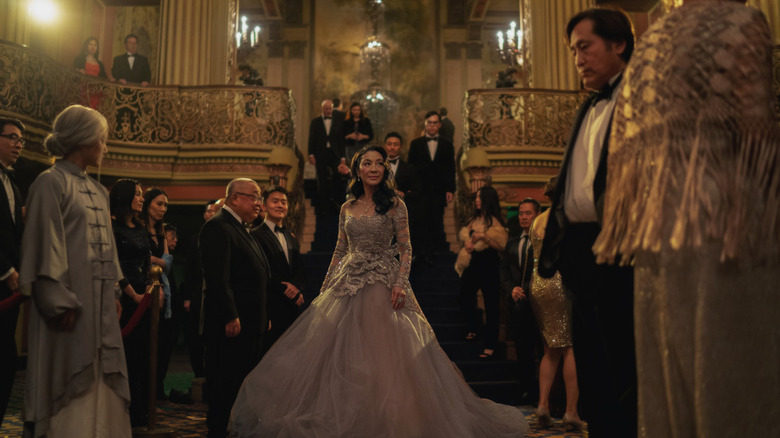Everything Everywhere All At Once Costume Designer On Experimentation And Her Influences [Interview]
Shirley Kurata's style tells a story. Whether it's on film, on a runway, or a television show, the costume designer and stylist's work gives a sense of history and the person behind the clothes. In the Daniels' "Everything Everywhere All at Once," Kurata helps establish universes, the film's punk rock hero, and in one homage to "In the Mood for Love," feelings of love and loss.
When Kurata isn't working in film and television, as she modestly put it, she's doing "non-movie related stuff," including but not limited to working on major ad campaigns, co-owning a clothing store (Virgil Normal) in Los Angeles, and styling Billie Eilish, the Lonely Island, and Miranda July in the past, to name a few. The costume designer, who knew she wanted to be a fashion designer when she was 10 years old and went on to fashion design in Paris at Studio Bercot, recently talked to us about her work on "Everything Everywhere All at Once."
"Maybe that's where the Jodorowsky in me comes into play"
You're a big Jodorowsky fan. When you worked on costumes for the bagelverse, were you thinking of "Holy Mountain?"
Yeah. I mean, that's one of them. I actually watched a lot of martial art films, just because there's a lot of it in the movie. Like Stephen Chow for me, I dug deep. I had already seen "Kung Fu Hustle" and "Shaolin Soccer," so I started trying to find some of his other movies, like the more obscure ones. That was great, and just trying to find some old Michelle Yeoh films, too. Obviously, re-watching "Crouching Tiger” and all that. Also, when I first met with the Daniels, I was just like, "Can you tell me some of the movies that influenced you, and that I should watch, in terms of preparation?" They had given me a couple names, one of them was "Holy Motors."
I had never seen it. I had watched that and I was like, "Oh wow, this is an amazing film." That was one of them. Another movie was "Paprika," which I hadn't seen either. It's like an anime, Japanese anime, which is amazing. Those two were the two that they listed. Then early on, there were movie nights. They're like, "Why don't we do movie nights just to get our creativity flowing and everything?" It got too busy for us, because we started shooting and then we were too tired after a long day to do it. I think they maybe had four or three, but I was only able to go to one and we watched "Groundhog Day."
That seems fitting.
Yeah, for sure. Those were the main sources of inspiration for me. Obviously, I like any Jodorowsky film, so [that] was in the back of my head, in terms of inspiration.
When it comes to design, I like your approach to using color, your belief that it has this power to unite, connect and create a family. Again, fitting for this movie's themes. So did you select costumes to emphasize that theme?
Yeah. Color is really important, especially like Chinese New Year, red is the color that they wear, generally, in celebrating it. I felt like I didn't want Joy to be in a full-on red thing, because I think she's rebelling against the whole family dynamic. There are hints of it. It's like red orange. I wanted to show that disconnect from that.
I think also, the worlds to me, having specific colors helps distinguish the worlds. I had no idea how they were going to cut it. I was like, "It's going to have to look different, quickly." Because I knew that there was going to be a lot of quick cuts. The hot dog Universe, I was like, "Well, let's just have the world be hot dog colors, beiges and pinks." All their wardrobe was like that color. I think just using that as a way of bringing the worlds together, it's an important tool for me.
How about the bagelverse? Were you thinking more retro sci-fi for that universe?
Yeah, for sure. Because sometimes for me, sci-fi can get a little cheesy, and I didn't want it to come off that way. I knew that the whole set was going to be white. I felt, well, let's keep it in that world, except for Michelle's character. Maybe that's where the Jodorowsky in me comes into play and just tying in a little bit of this historical [vibe], with the Elizabethan ruff that she's wearing. She's wearing this vinyl bodysuit and this pleated skirt. I think it was made out of almost like a synthetic, almost like shower curtain material. Using some of those futuristic fabrics, but then still bringing old and new together, which is what I like doing. I like mixing it up.
Were a lot of the costumes made from scratch?
Well, I was working with a limited budget. I didn't necessarily always have the means to make from scratch, because that gets expensive. For the bagel universe, I had reached out to, just because I'm working as a stylist and doing non-movie related stuff, there's a designer named Claudia Lee. I just reached out to her like, "Hey, would you be interested in helping make some costumes for this film?" She was totally down. She made all the gowns that the followers were wearing. Then the skirts that Jobu is wearing is hers. She also made the plaid cape work for Jobu. That was a custom thing.
Some of the others are piecing together. When we go into the alpha verse and they're in the van, I wanted to play off of the little bit dystopian kind of world. I got a bunch of vintage, military army-liners and different pieces and then had that reworked and made costumes out of that. It's just a reworked piece.
"She is kind of punk rock"
When it comes to Jobu's array of costumes, how much experimenting was involved?
Well, some of them were written in the script, like the Elvis costume. That was something that Daniels thought of. Then after, we started brainstorming about different looks that could be good that were totally different. I think some of it was a little bit of a dig at the Asian stereotypes, like the visors. I'm trying to think, because the first time we saw Jobu, we didn't want to reveal her identity, that it was Jobu/Joy. We shot this all pre-lockdown. Covid was maybe in China, but there were maybe early cases happening. We had no idea it was going to happen at that point when I was prepping it.
For me, it was just like, "Oh, well, Asians, they always wear masks." Because if they're sick, they're just being respectful. That's a good way to disguise a face, let's have a matching visor and let's just have our own plaid. No idea what this would be like, that the mask would be such a staple in what everyone wears.
We shot this and Covid just started to become more and more discussed, to the point where the last day of shooting, we did an all-nighter, wrapped the Saturday morning, which was the Saturday before the first day of lockdown. That was the progression of like, "Okay, what's going on?"
I'm so glad that the timing was almost perfect. We had to push some, like pick-up shots and green screenshots. For the most part, the principal of photography was right before lockdown. That was interesting, because we had no idea what was in store for us. Going back to playing on some of the Asian stereotypes and stuff. There's also the K-pop star or the golfer. We just decided to pick what we thought would be good. There's also the goth anime. It was just this fun, cool, different looks that I think that her character would embrace. It was also the pro-wrestler look.
I think that the Daniels were very open. They were like, "Yeah, just send me ideas about what you think, what you can find, what you think are good." We just built off of that. The scene where she's getting sucked up into the bagel, they wanted something, because she falls on the stairs. They called it the jumbled Jobu, which is everything just gets mixed up.
I took elements from all her other costumes and just freehanded draped it on a jumpsuit, but you can't tell that there's a jumpsuit underneath. It's the gloves, and there's an elbow pad or something that was part of her resting costume and then elements of plaid, because you see her wearing plaid. Just throwing it all in. It just looked like it was thrown together. That was an idea with the Daniels, this jumbled Jobu look.
You're a native Angeleno and a large part of this movie is based in Los Angeles. Where'd you go for those costumes?
I was actually so happy when I found out that they were shooting here. Because a lot of productions have been going to Canada or Atlanta or out of state. I think it was Daniel Kwan who just had the baby, so they wanted to keep it local, and I thought that was great. One thing I love is, I love Chinatown here. I love the architecture, the history, and I love shopping there. I'm pretty familiar with the stuff that they were selling. I would say almost 90% of Michelle, Waymond's, and James Hong's clothing were shopped in Chinatown.
Everything's super cheap. I felt like it's a specific style that really works for these characters. Also, in terms of fit and style. It's hard to explain, but it's stuff that you don't find or see necessarily in regular stores, like mall stores or department stores here. I felt like it was the perfect place to shop for them, including that punk sweater that she's wearing. Because we were like, "Where'd you get that sweater?" I think it was like, I don't know, some hip designers or something. I found that sweater in Chinatown.
Which sweater exactly?
It's a sweater that Evelyn, Michelle, wears at the laundromat during the Chinese New Year party. Because a lot of people are asking like, "Where'd you get that? Did you have that made?" I was like, "No, I found it as is." That's the one thing that's sometimes fun about when you get stuff from other countries and there's a word on it or multiple words where you're like, "What does this mean?" The sweater's very like something a mom or grandma would wear, but punk. I thought it was perfect, because it also nods to Michelle's character, in terms of like, she is kind of punk rock. She realizes it, but you don't get that impression in the beginning.
She didn't think that she was, but there is an element of her being punk. I also feel like the fact that she left her country, and her parents do not approve, and moved to the States to start a business — that takes a lot of balls to do. I think we need to give credit to all the immigrant parents that have done that. It's a difficult thing. There's an element of punk rock to that.
"We referenced Wong Kar-wai"
Did you design any costumes for worlds we don't see in the finished film?
Yeah. There were a lot more worlds that were scripted that we didn't end up shooting or outfits or whatever. It was even more dense in the script.
What were some of those other worlds?
There was one where it was more like a Viking battle between Jobu and Evelyn. That was one of them. Well, there was one that didn't involve me, thankfully, because it was like a spaghetti universe. I think it was like a macaroni in the world of spaghetti or something. There were several things, because the movie is already quite long, that they had to cut certain scenes.
For the movie star universe, what were your references there?
I know for the movie-star universe, obviously, we referenced Wong Kar-wai, whose films I love. Also, it was a nod to Michelle Yeoh as an actress. I had asked her, "Are there brands you like to wear on the red carpet?" She had a relationship with a designer, Elie Saab, and she wears a lot of his dresses. They sent us some options. I got a few by some other designers, but the one that she ended up wearing is by Elie Saab. It's like something that Michelle Yeoh would wear on a red carpet. That's where we landed with that look.
How'd you land on the hot dog suit?
The hot dog, I just wanted her to mirror Deidre's outfit in the IRS universe, but in that beige tan world.
I like that connection, but also how you used warm colors for Deidre, especially when you realize she's actually a very warm person who also needs a breather.
Exactly. Also, the colors that she wears will really work well in that boring environment that is the IRS building. Evelyn, being more on this like plum, burgundy, purple world, I felt it seemed right.
Everyone I've talked to about this movie said just how short time was. Given how dense the vision for this movie is, it's even more remarkable. Were you also on a time crunch?
It was pretty fast. I have to say, the Daniels, they were just so great to work with. They were so patient. The script was one of the hardest scripts to break down. I had to read it about 20 times to fully understand it. Watching it, it's much more cohesive, but it's still very dense. In one scene, she changes 10 times. You're just like, "Wait." There are so many questions and I had to constantly ask them — I'm sure every department did. They were always so patient and so happy to give you the answers.
They even said, "If we give you an idea and you can't execute it because of time or money, just let us know and we'll come up with another solution." That's what we did with certain aspects of it. I think because they were so open to that and so easy to work with on that level, that made it manageable.
For example?
For example, "2001: A Space Odyssey," those monkeys. The Daniels were like, "We want it to look crappy, like the movie monkey suits." I was like, "I know, but I'm not finding really good existing ones. We should probably get it made, but that's very expensive to make, even if it looks somewhat a little bit crappy, it is still expensive." They're like, "Well, see what you can find." I found the best-looking monkey suit, but it was still awful, so cheap. We gave it to the special effects department. I was like, "Can you just try to make it look better?" They managed to do it, which was amazing. I'm grateful for that.
"Everything Everywhere All at Once" is in wide release now.



